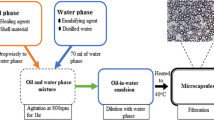Abstract
Microencapsulated healing agents that possess adequate strength, long shelf-life, and excellent bonding to the host material are required for self-healing materials. The in situ encapsulation method is demonstrated over an order of magnitude size reduction for the preparation of urea-formaldehyde (UF) capsules filled with a healing agent, a mixture epoxy resin of the epoxy 711 and E-51. Capsules with diameters as small as about 100 μm are achieved under the agitation rate of 800 r min−1. The capsules possess a uniform UF shell wall (4 μm average thickness). By using the analysis of scanning electronic microscope (SEM), thermal analysis (TG-DTA) and FTIR, the characteristics of the microcapsules were investigated respectively. Successful self-healing has been demonstrated for anticorrosion covering materials with microcapsules.
Article PDF
Similar content being viewed by others
Avoid common mistakes on your manuscript.
References
Eukaszczyk J, Urba P. Influence of the parameters of encapsulation process and of the structure of diisocyanates on the release of codeine from resinate encapsulated in polyurea by interfacial water promoted polyreaction. React Funct Polym, 1997, 33: 233–239
Tiyaboonchai W, Ritthidej G C. Development of indomethacin sustained release microcapsules using chitosan-carboxymethyl-cellulose complex coacervation. Songklanakarin J Sci Technol, 2003, 25: 245–254
Park B J, Lee J Y, Sung J H, et al. Microcapsules containing electrophoretic suspension of TiO2 modified with poly (methyl methacrylate). Appl Phys, 2006, 6: 632–635
Saihi D, Vroman I, Girand S, et al. Microencapsulation of ammonium phosphate with a polyurethane shell. Part II. Interfacial polymerization technique. React Funct Polym, 2005, 64: 127–138
Girand S, Bourbigot S, Rochery M, et al. Flame retarded polyurea with microencapsulated ammonium phosphate for textile coating. Polym Degrad Stabil, 2005, 88: 106–113
Liu X D, Ataroshi T, Furuta T, et al. Microencapsulation of emulsified hydrophobic flavors by spray drying. Drying Technol, 2001, 19: 1361–1374
Park S J, Shin Y S, Lee J R. Preparation and characterization of microcapsules containing lemon oil. J Colloid Interface Sci, 2001, 241: 502–508
Orive G, Herna’ndez R M, Gasco’n A R, et al. Encapsulated cell technology: From research to market. Trends Biotechnol, 2002, 20: 382–387
Sukhorukov G, Fery A, Möhwald H. Intelligent micro- and nanocapsules. Prog Polym Sci, 2005, 30: 885–897
Ji H B, Kuang G J, Qian Y. Development of an immobilization method by encapsulating inorganic metal salts forming hollow microcapsules. Catal Today, 2005, 105: 605–611
Brown E N, Kessler M R, Sottos N R, et al. In situ poly (urea-formaldehyde) microencapsulation of dicyclopentadiene. J Microencapsul, 2003, 20: 719–730
Lamaka S V, Zheludkevich M L, Yasakau K A, et al. TiOx self-assembled networks prepared by templating approach as nanostructured reservoirs for self-healing anticorrosion pre-treatments. Electrochem Commun, 2006, 8: 421–428
White S R, Sottos N R, Geubelle P H, et al. Autonomic healing of polymer composites. Nature, 2001, 409: 794–800
Yuan L, Liang G Z, Xie J Q, et al. Preparation and characterization of poly (urea-formaldehyde) microcapsules filled with epoxy resins. Polymer, 2006, 47: 5338–5349
Yin T, Rong M Z, Zhang M Q, et al. Self-healing epoxy composites preparation and effect of the healant consisting of microencapsulated epoxy and latent curing agent. Compos Sci Technol, 2007, 67: 201–212
Yuan L, Liang G Z, Xie J Q, et al. Thermal stability of microencapsulated epoxy resins with poly (urea-formaldehyde). Polym Degrad Stab, 2006, 91: 2300–2305
Taylor G I. The visocity of a fluid containing small drops of another fluid. Proc R Soc London Ser A, 1932, 138: 41–48
Dobetti L, Pantaleo V. Application of a hydrodynamic model to microencapsulation by coacervation. J Microencapsulation, 2002, 19: 139–151
Camino G, Operti L, Trossarelli L. Mechanism of thermal degradation of urea-formaldehyde polycondensates. Polym Degrad Stab, 1983, 5: 161–172
Zhang X X, Tao X M, Yick K L, et al. Structure and thermal stability of microencapsulated phase-change materials. Colloid Polym Sci, 2004, 282: 330–336
Author information
Authors and Affiliations
Corresponding author
Additional information
This article is published with open access at Springerlink.com
Rights and permissions
This article is published under an open access license. Please check the 'Copyright Information' section either on this page or in the PDF for details of this license and what re-use is permitted. If your intended use exceeds what is permitted by the license or if you are unable to locate the licence and re-use information, please contact the Rights and Permissions team.
About this article
Cite this article
Liao, L., Zhang, W., Xin, Y. et al. Preparation and characterization of microcapsule containing epoxy resin and its self-healing performance of anticorrosion covering material. Chin. Sci. Bull. 56, 439–443 (2011). https://doi.org/10.1007/s11434-010-4133-0
Received:
Accepted:
Published:
Issue Date:
DOI: https://doi.org/10.1007/s11434-010-4133-0




